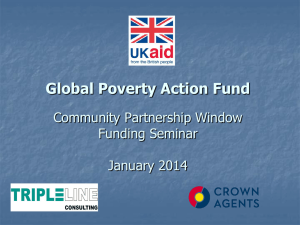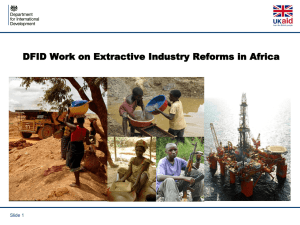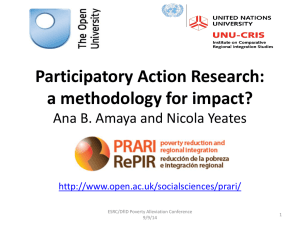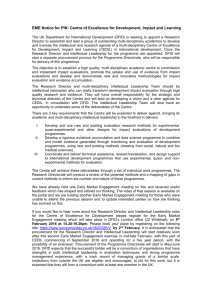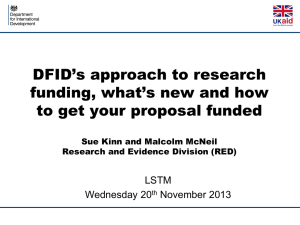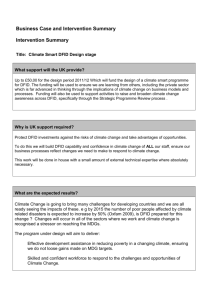International Actions to support Extreme Poverty Reduction
advertisement
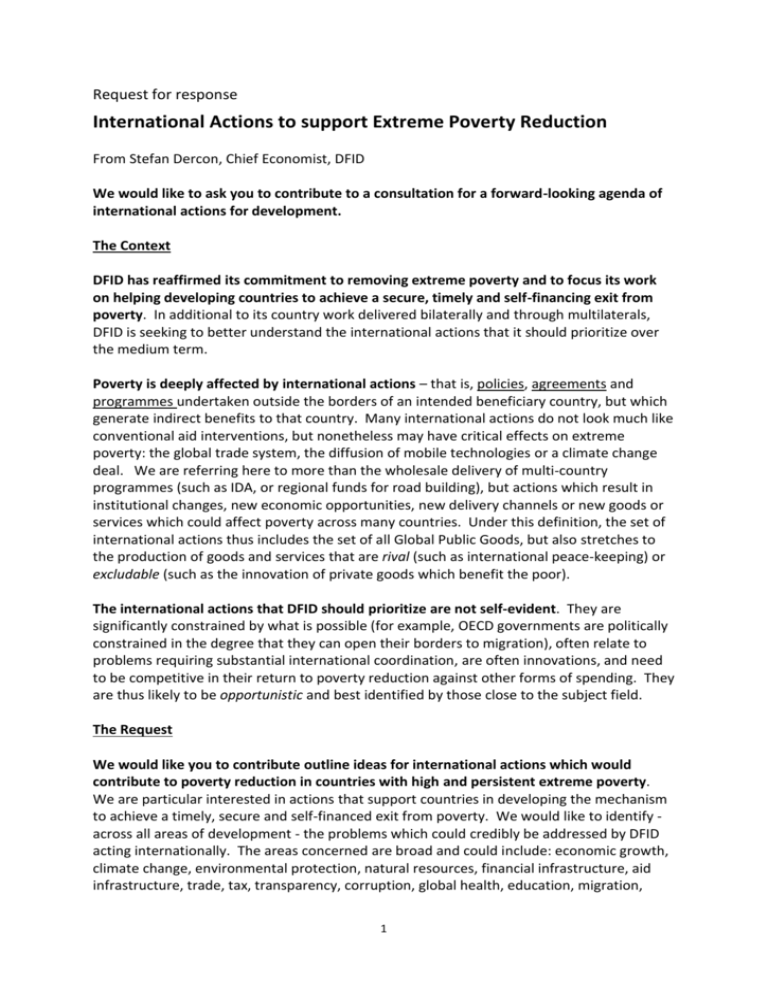
Request for response International Actions to support Extreme Poverty Reduction From Stefan Dercon, Chief Economist, DFID We would like to ask you to contribute to a consultation for a forward-looking agenda of international actions for development. The Context DFID has reaffirmed its commitment to removing extreme poverty and to focus its work on helping developing countries to achieve a secure, timely and self-financing exit from poverty. In additional to its country work delivered bilaterally and through multilaterals, DFID is seeking to better understand the international actions that it should prioritize over the medium term. Poverty is deeply affected by international actions – that is, policies, agreements and programmes undertaken outside the borders of an intended beneficiary country, but which generate indirect benefits to that country. Many international actions do not look much like conventional aid interventions, but nonetheless may have critical effects on extreme poverty: the global trade system, the diffusion of mobile technologies or a climate change deal. We are referring here to more than the wholesale delivery of multi-country programmes (such as IDA, or regional funds for road building), but actions which result in institutional changes, new economic opportunities, new delivery channels or new goods or services which could affect poverty across many countries. Under this definition, the set of international actions thus includes the set of all Global Public Goods, but also stretches to the production of goods and services that are rival (such as international peace-keeping) or excludable (such as the innovation of private goods which benefit the poor). The international actions that DFID should prioritize are not self-evident. They are significantly constrained by what is possible (for example, OECD governments are politically constrained in the degree that they can open their borders to migration), often relate to problems requiring substantial international coordination, are often innovations, and need to be competitive in their return to poverty reduction against other forms of spending. They are thus likely to be opportunistic and best identified by those close to the subject field. The Request We would like you to contribute outline ideas for international actions which would contribute to poverty reduction in countries with high and persistent extreme poverty. We are particular interested in actions that support countries in developing the mechanism to achieve a timely, secure and self-financed exit from poverty. We would like to identify across all areas of development - the problems which could credibly be addressed by DFID acting internationally. The areas concerned are broad and could include: economic growth, climate change, environmental protection, natural resources, financial infrastructure, aid infrastructure, trade, tax, transparency, corruption, global health, education, migration, 1 security, conflict, humanitarian, governance, security, social policy, human rights, women and girls, etc. We hope to generate a large set of potential international actions to inform DFID’s priorities in the coming 5 years or more. DFID’s main scarce resource here is time, not spend. Please send outline ideas for international actions for development of two pages or less. Please don’t send us long proposals, research papers or links – we need short structured contributions for now, even though they can refer to other relevant documents. Please structure them around the following questions: (a) What is the bottleneck that limits the ability of poor countries and their poor populations to escape poverty in a secure, timely and self-financed way? (b) Why does it need to be resolved by international action and coordination? (c) How can progress be achieved in the near future (2-5 years)? What outcome is feasible? (d) Would this have a competitive return compared to other development interventions? (e) Why DFID? Please send replies to Christopher Eleftheriades C-Eleftheriades@DFID.gov.uk in the Chief Economist’s Office by 25 March 2014. How will we use this? We will collate the ideas, and share them in DFID. We will offer them to the relevant policy teams, as a ‘diagnostic’ of problems and possible opportunities for solutions to help DFID to continue to make a coherent development offer to the world. 2 Appendix: some further clarifications International Action. DFID’s international action aims to promote policies, agreements and programmes at the international level that support poverty reduction in developing countries, particularly those where extreme poverty is concentrated (see geographical focus below). Our international work supports and complements the work of our bilateral programmes. Furthermore, we work internationally by working for relevant international or regional agreements and commitments, supporting effective multilateral programmes, and building a strong network of relationships that together create a supportive international environment. Examples might be: a global arms trade agreement, an agreement on entry for humanitarian aid for a specific conflict, a trade agreement, a climate change deal, recognition of the ICC, a mechanism to overcome IPR to get generic drugs in particular countries, effective election monitoring, coordination with religious leaders to enrol them to induce behavioural change on vaccination attitudes, cross-cultural global behavioural change on early marriage etc. (Note that an international action is not just a multi-country action like a regional infrastructure program, but would focus on the multi-country agreements that make this possible.) The gap. Here, we are concerned with DFID’s policy and partnership work that aims to create and support international action of what is often called the production of “global public goods”. Global is used to reflect issues that have cross-border relevance, but can include regional issues. The focus here is on the agreements, rules, and norms, and their enforcement that are currently bottlenecks for poor countries, and poor people in general, and that require international action to overcome them. They are problems that without international coordination cannot be resolved. Defining international actions. The term “public goods” stems from economics and confuses even sharp economists. Intuitively, it refers to problems whose solution is seriously hampered by the need for coordinated action or at least a careful consideration of multiple interests; there is a coordination failure.1 The term international actions is preferred as it captures better this essential nature of the problem: to resolve it we need to coordinate in a way that goes beyond just issues DFID, HMG or the country involved may control. Note this should not be simply about something better done together than apart for economies of scale (say, a multi-donor programme to deliver sanitation) – these are more fundamental issues. Often, the term GPGs is used for almost anything internationally. Renovating health centres in 5 countries, via a multi-country programme does not involve a GPG. Nor does a regional fund for road building. Some programmes may contribute to the development of GPGs, but 1 The economist would say: there is a market failure in the production of this good or service, in the form of an externality, that means that ‘socially optimal’ levels of provision of this good are only obtained if the interests of the affected parties (costs and benefits to those parties that are affected by the externality) are properly taking into account. This type of market failure can be interpreted as a coordination failure as only if the interests of all are properly taking into account would we reach the socially optimal production levels. The externality stems from the characteristics of the good – it is non-rival and non-excludable (a pure public good requires both characteristics, but many goods have public good characteristics, in terms of some limits to rivalry and excludability). Hopefully you can see how confusing the use of the term public good in this context may be – it is a difficult term and boundaries are a bit fuzzy. 3 the outputs are not the GPG: a multi-country programme on renovating customs posts may help to induce countries to open their borders, but in itself is not the GPG. Paying for the development of a vaccine for an infectious disease is not a GPG but an agreement on the mechanism that overcomes the IPR problem and ensures that it is widely available on the ground is a GPG – which requires the vaccine to be there. Geographical Footprint. DFID has recently redefined its geographical footprint, in terms of countries where the current prospects of the poor are limited (because growth is limited and/or it does not translate in sufficient poverty reduction) and that don’t have the ability to self-finance poverty reduction entirely. The list is reproduced below. In this exercise we are focusing on identifying those international actions that have the largest impact on poor people in these countries (although they could matter for poor people in other countries too). Tier 1 includes countries where DFID has a bilateral programme; Tier 2 countries tend to be reached via multilateral programmes and processes. Tier 1: Afghanistan, Bangladesh, DRC, Ethiopia, Ghana, Kenya, Kyrzyg Republic, Liberia, Malawi, Mozambique, Myanmar, Nepal, Nigeria, Pakistan, Rwanda, Sierra Leone, Somalia, South Sudan, Sudan, Tajikistan, Tanzania, Uganda, Yemen, Zambia, Zimbabwe; Tier 2: Benin, Burkina Faso, Burundi, Central African Republic, Chad, The Gambia, Comoros, Côte d'Ivoire, Eritrea, Guinea, Guinea-Bissau, Haiti, Honduras, Lesotho, Madagascar, Mali, Mauritania, Niger, Togo, Papua New Guinea, Republic of Congo, Senegal. 4




